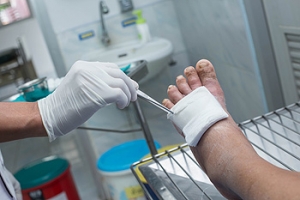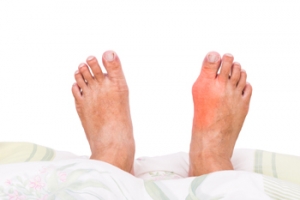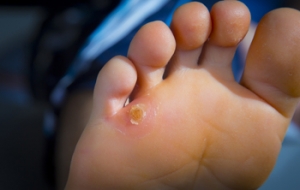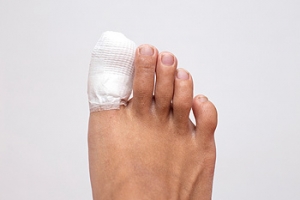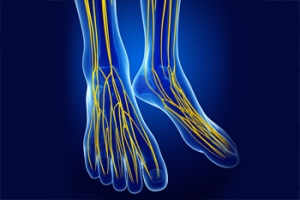Super User
What is Morton's Neuroma?
Morton’s neuroma, (also referred to as Morton’s metatarsalgia, Morton’s neuralgia, plantar neuroma or intermetatarsal neuroma) is a condition that is caused when the tissue around one of the nerves between your toes begins to thicken. This thickening can result in pain in the ball of the foot. Fortunately, the condition itself is not cancerous.
Morton’s neuroma affects women more often than men with a ratio of 4:1. It tends to target women between the age of 50 and 60, but it can occur in people of all ages. There are some risk factors that may put you at a slightly higher risk of developing the condition. People who often wear narrow or high-heeled shoes are often found to be linked to Morton’s neuroma. Additionally, activities such as running or jogging can put an enormous amount of pressure on the ligament and cause the nerve to thicken.
There usually aren’t any outward symptoms of this condition. A person who has Morton’s neuroma may feel as if they are standing on a pebble in their shoe. They may also feel a tingling or numbness in the toes as well as a burning pain in the ball of their foot that may radiate to their toes.
In order to properly diagnose you, the doctor will press on your foot to feel for a mass or tender spot. He may also do a series of tests such as x-rays, an ultrasound, or an MRI. X-rays are usually done to rule out any other causes for your foot pain such as a stress fracture. Ultrasounds are used to reveal soft tissue abnormalities that may exist, such as neuromas. Your podiatrist may want to use an MRI in order to visualize your soft tissues.
There are three main options for treatment of Morton’s neuroma: Injections, decompression surgery, and removal of the nerve. Injections of steroids into the painful area have been proven to help those with Morton’s neuroma. Decompression surgery has been shown to relieve pressure on the affected nerve by cutting nearby structures such as the ligaments in the foot. Another treatment option would be to surgically remove the growth to provide pain relief.
If you suspect that you have Morton’s neuroma you should make an appointment with your podiatrist right away. You shouldn’t ignore any foot pain that lasts longer than a few days, especially if the pain does not improve.
Can Running Injuries Be Prevented?
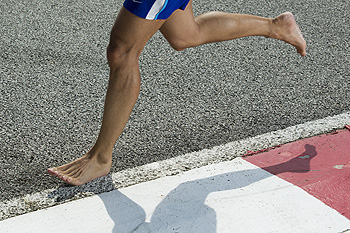 Some running injuries may be prevented by practicing proper training methods. The feet are often affected by running injuries, and unfortunately this can make it quite difficult to accomplish daily activities. It is important to strengthen the body, and this may help to gradually increase the mileage and intensity of your runs. It is beneficial to build strength in the legs separately, helping to decrease injury risk. Reverse lunges are known to improve stability, in addition to strengthening the lower part of the body. Flexibility in the hips and glutes may be increased when single leg deadlifts are frequently performed, and may become more challenging when a weight is held. If you would like additional information about how to prevent running injuries, please speak with a podiatrist.
Some running injuries may be prevented by practicing proper training methods. The feet are often affected by running injuries, and unfortunately this can make it quite difficult to accomplish daily activities. It is important to strengthen the body, and this may help to gradually increase the mileage and intensity of your runs. It is beneficial to build strength in the legs separately, helping to decrease injury risk. Reverse lunges are known to improve stability, in addition to strengthening the lower part of the body. Flexibility in the hips and glutes may be increased when single leg deadlifts are frequently performed, and may become more challenging when a weight is held. If you would like additional information about how to prevent running injuries, please speak with a podiatrist.
Exercising your feet regularly with the proper foot wear is a great way to prevent injuries. If you have any concerns about your feet, contact Dr. John Branwell of Kearny, New Jersey. Our doctor will treat your foot and ankle needs.
How to Prevent Running Injuries
Many common running injuries are caused by overuse and overtraining. When the back of the kneecap starts wearing out and starts causing pain in your knee, this is commonly referred to as runner’s knee. Runner’s knee is a decrease in strength in your quadriceps and can occur if you’re not wearing properly fitted or supporting shoes. To prevent runner’s knee, focusing on hip strengthening is a good idea, as well as strengthening your quads to keep the kneecaps aligned.
What Are Some Causes of Running Injuries?
- One cause of a common running injury is called iliotibial band syndrome.
- Plantar fasciitis is also another common injury.
- Stress fractures can occur from overtraining, lack of calcium, or even your running style.
Best Ways to Prevent Running Injuries
- Wear footwear that fits properly and suits your running needs.
- Running shoes are the only protective gear that runners have to safeguard them from injury.
- Make a training schedule. Adding strengthening exercises as well as regular stretching can help keep you strong and limber and can lessen the possibility of injuries.
- Stretching keeps muscles limber; this will help you gain better flexibility.
If you have any questions please feel free to contact our office located in Kearny, NJ . We offer the newest diagnostic and treatment technologies for all your foot and ankle needs.
Daily Foot Checks Are Necessary for Diabetic Patients
 If you are afflicted with diabetes, it is beneficial to check your feet daily, regardless of whether or not they feel fine. There may be a tiny cut or scrape that has occurred, which may lead to an infection. Diabetes can also often affect the nerves. The symptoms of neuropathy, a common condition among diabetic patients can include a loss of sensation in the feet. This may cause the inability to feel changes to the feet. This is why it is helpful to perform daily foot checks. Diabetic patients should always wear shoes and socks, and this is an adequate method of protecting the feet from potential damage. When the toenails are trimmed correctly, ingrown toenails may be avoided. If you have diabetes, it is strongly suggested that you seek the professional care of a podiatrist who can help you to properly manage this condition.
If you are afflicted with diabetes, it is beneficial to check your feet daily, regardless of whether or not they feel fine. There may be a tiny cut or scrape that has occurred, which may lead to an infection. Diabetes can also often affect the nerves. The symptoms of neuropathy, a common condition among diabetic patients can include a loss of sensation in the feet. This may cause the inability to feel changes to the feet. This is why it is helpful to perform daily foot checks. Diabetic patients should always wear shoes and socks, and this is an adequate method of protecting the feet from potential damage. When the toenails are trimmed correctly, ingrown toenails may be avoided. If you have diabetes, it is strongly suggested that you seek the professional care of a podiatrist who can help you to properly manage this condition.
Diabetic foot care is important in preventing foot ailments such as ulcers. If you are suffering from diabetes or have any other concerns about your feet, contact Dr. John Branwell from Kearny, New Jersey. Our doctor can provide the care you need to keep you pain-free and on your feet.
Diabetic Foot Care
Diabetes affects millions of people every year. The condition can damage blood vessels in many parts of the body, especially the feet. Because of this, taking care of your feet is essential if you have diabetes, and having a podiatrist help monitor your foot health is highly recommended.
The Importance of Caring for Your Feet
- Routinely inspect your feet for bruises or sores.
- Wear socks that fit your feet comfortably.
- Wear comfortable shoes that provide adequate support.
Patients with diabetes should have their doctor monitor their blood levels, as blood sugar levels play such a huge role in diabetic care. Monitoring these levels on a regular basis is highly advised.
It is always best to inform your healthcare professional of any concerns you may have regarding your feet, especially for diabetic patients. Early treatment and routine foot examinations are keys to maintaining proper health, especially because severe complications can arise if proper treatment is not applied.
If you have any questions please feel free to contact our office located in Kearny, NJ . We offer the newest diagnostic and treatment technologies for all your foot and ankle needs.
How to Care for Diabetic Foot
Millions of people are affected by diabetes each year. Diabetes damages blood vessels in all parts of the body, especially the feet. The legs and feet may develop slow blood flow, which causes neuropathy, or nerve damage. Once a diabetic patient develops neuropathy, it is important that the feet are well taken care of. Otherwise, the lower limbs may have to be amputated. This only happens in drastic cases, but it shows how seriously diabetic foot care should be taken.
It is very important to always wash and dry the feet thoroughly, especially in between the toes, if you’re a diabetic. Secondly, examining your feet and toes for redness or sores must be done, even if you do not feel pain. You may also want to examine your feet from the bottom. Try to avoid wearing colored socks to prevent infections that may occur from the dye. Well-fitting socks are also highly recommended.
A diabetic’s physician should always monitor their blood levels to test how well blood sugars are being maintained. In addition to giving advice about everyday eating habits and foot care, a physician may prescribe medicine to help with the diabetic patient’s neuropathy. It is also advised to see a podiatrist if experiencing any feet conditions. Toenails may also need to be taken care of by a podiatrist. This prevents patients from cutting too deeply around their cuticles, which can lead to infection.
A person can take care of their feet at home by following the instructions of their physician. Using creams on one’s feet is also an effective way to heal dryness. Proceed with caution when using tools to remove calluses, as severe diabetics may not be able to feel pain on their feet. If any complications arise do not hesitate to contact a podiatrist.
On a daily basis, diabetic feet must be checked. If you are ever concerned about something, contact your health care professional. You never want to wait until a wound becomes too severe to treat. If left untreated, gangrene may develop. Gangrene is a serious infection that can lead to sepsis or amputation. It is also important for diabetics to be on the lookout for ulcers. Ulcers are sores that develop from tissue loss on the skin. They can be quite painful and require intensive treatment. Early treatment and everyday inspection are imperative to staying healthy.
Can Children Get Bunions?
A bunion (Hallux Valgus) is a bony bump where the big toe joint attaches to the foot. While bunions are more prevalent in adults, they do occur in children and, especially girls. Having loose joints, feet that roll inward, and other structural anomalies in the feet can all contribute to the formation of a bunion. Other factors such as heredity and wearing narrow or high-heeled shoes play a part as well. To help prevent bunions from developing, parents should make sure the shoes their children wear are fitted properly, and switched out as frequently as the child’s foot grows. If the child complains of pain in the bone just behind the big toe (first metatarsal), has a sore bump, swelling at the base of the big toe, discomfort while walking, or a numb or burning sensation, this may be an indication of a pediatric bunion. It is suggested that a podiatrist be consulted for an examination and X-ray to help diagnose and treat the issue.
If you are suffering from bunions, contact Dr. John Branwell of Kearny, New Jersey. Our doctor can provide the care you need to keep you pain-free and on your feet.
What Is a Bunion?
A bunion is formed of swollen tissue or an enlargement of boney growth, usually located at the base joint of the toe that connects to the foot. The swelling occurs due to the bones in the big toe shifting inward, which impacts the other toes of the foot. This causes the area around the base of the big toe to become inflamed and painful.
Why Do Bunions Form?
Genetics – Susceptibility to bunions are often hereditary
Stress on the feet – Poorly fitted and uncomfortable footwear that places stress on feet, such as heels, can worsen existing bunions
How Are Bunions Diagnosed?
Doctors often perform two tests – blood tests and x-rays – when trying to diagnose bunions, especially in the early stages of development. Blood tests help determine if the foot pain is being caused by something else, such as arthritis, while x-rays provide a clear picture of your bone structure to your doctor.
How Are Bunions Treated?
- Refrain from wearing heels or similar shoes that cause discomfort
- Select wider shoes that can provide more comfort and reduce pain
- Anti-inflammatory and pain management drugs
- Orthotics or foot inserts
- Surgery
If you have any questions, please feel free to contact our office located in Kearny, NJ . We offer the newest diagnostic and treatment technologies for all your foot care needs.
Hard, Soft, and Seed Corns
 Corns are a buildup of hard skin that usually occurs on the tops or sides of the toes. They get their name from their appearance, which resembles a corn kernel. There are three types of corns: hard, soft, and seed. A hard corn is small, made up of dead skin, and has a packed center. A soft corn is more pliable and typically found between the fourth and fifth toes. A seed corn is tiny, but can be very tender and painful depending on its location. Unlike hard and soft corns, seed corns are usually found on the soles of the feet. Corns generally arise due to friction from ill-fitting shoes or socks. If you have corns on your feet that are bothering you it is suggested that you speak with a podiatrist.
Corns are a buildup of hard skin that usually occurs on the tops or sides of the toes. They get their name from their appearance, which resembles a corn kernel. There are three types of corns: hard, soft, and seed. A hard corn is small, made up of dead skin, and has a packed center. A soft corn is more pliable and typically found between the fourth and fifth toes. A seed corn is tiny, but can be very tender and painful depending on its location. Unlike hard and soft corns, seed corns are usually found on the soles of the feet. Corns generally arise due to friction from ill-fitting shoes or socks. If you have corns on your feet that are bothering you it is suggested that you speak with a podiatrist.
Corns can make walking very painful and should be treated immediately. If you have questions regarding your feet and ankles, contact Dr. John Branwell of Kearny, New Jersey. Our doctor will treat your foot and ankle needs.
Corns: What Are They? And How Do You Get Rid of Them?
Corns are thickened areas on the skin that can become painful. They are caused by excessive pressure and friction on the skin. Corns press into the deeper layers of the skin and are usually round in shape.
Ways to Prevent Corns
There are many ways to get rid of painful corns such as:
- Wearing properly fitting shoes that have been measured by a professional
- Wearing shoes that are not sharply pointed or have high heels
- Wearing only shoes that offer support
Treating Corns
Although most corns slowly disappear when the friction or pressure stops, this isn’t always the case. Consult with your podiatrist to determine the best treatment option for your case of corns.
If you have any questions please feel free to contact our office located in Kearny, NJ . We offer the newest diagnostic and treatment technologies for all your foot and ankle needs.
Running Is Difficult With a Broken Toe
 People who enjoy running or jogging may find it difficult to perform these activities with a broken toe. It is a common occurrence among people who participate in sporting activities, and runners may be unhappy with taking needed time off from their chosen sport to heal the toe properly. Additionally, a broken toe can occur from dropping a heavy object on it, or from jamming it into a piece of furniture. Some of the symptoms that are associated with this ailment can consist of immediate bruising, swelling, and it may be difficult to walk. An effective treatment method can include buddy taping. This is accomplished by taping the affected toe to the toe next to it, and resting it as often as possible. Research has indicated the average time for a broken toe to heal is approximately six weeks and it is important to limit running during this time. If you are experiencing symptoms of a broken toe it is suggested that you consult with a podiatrist who can effectively treat this condition.
People who enjoy running or jogging may find it difficult to perform these activities with a broken toe. It is a common occurrence among people who participate in sporting activities, and runners may be unhappy with taking needed time off from their chosen sport to heal the toe properly. Additionally, a broken toe can occur from dropping a heavy object on it, or from jamming it into a piece of furniture. Some of the symptoms that are associated with this ailment can consist of immediate bruising, swelling, and it may be difficult to walk. An effective treatment method can include buddy taping. This is accomplished by taping the affected toe to the toe next to it, and resting it as often as possible. Research has indicated the average time for a broken toe to heal is approximately six weeks and it is important to limit running during this time. If you are experiencing symptoms of a broken toe it is suggested that you consult with a podiatrist who can effectively treat this condition.
Broken toes may cause a lot of pain and should be treated as soon as possible. If you have any concerns about your feet, contact Dr. John Branwell from Kearny, New Jersey. Our doctor will treat your foot and ankle needs.
What Is a Broken Toe?
A broken toe occurs when one or more of the toe bones of the foot are broken after an injury. Injuries such as stubbing your toe or dropping a heavy object on it may cause a toe fracture.
Symptoms of a Broken Toe
- Swelling
- Pain (with/without wearing shoes)
- Stiffness
- Nail Injury
Although the injured toe should be monitored daily, it is especially important to have a podiatrist look at your toe if you have severe symptoms. Some of these symptoms include worsening or new pain that is not relieved with medication, sores, redness, or open wounds near the toe.
If you have any questions, please feel free to contact our office located in Kearny, NJ . We offer the newest diagnostic and treatment technologies for all your foot care needs.
What to Know About a Broken Toe
The forefoot is composed of five metatarsal bones and fourteen phalanges. Each toe has three phalanges except for the big toe which only has two. Our toes play an essential role to the walking process, which is why a broken toe could seriously disrupt one’s ability to move around. Toe fractures are common and can be very painful. Fortunately, these injuries rarely require surgery and usually heal with rest and a change in activity.
Broken toes typically result from a traumatic event such as falling, stubbing the toe, or dropping something on the toe. Traumatic toe fractures may be categorized as either minor or severe fractures. At times, one may hear a “pop” or “crack” sound when the bone breaks. Common symptoms of a traumatic toe fracture include pain, throbbing, bruising, swelling, and redness.
Another type of toe fractures is a stress fracture. These injuries usually appear in the form of small hairline breaks on the bone. Stress fractures develop after repetitive activity instead of a single injury. Stress fractures occur when the muscles in the bone become too weak to absorb impact. Consequently, the toe bone becomes vulnerable to any pressure and impact it endures. Symptoms for a stress fracture in the toe include swelling without bruising, tenderness to the touch, pain that goes away with rest, and pain after walking or running.
If you suspect that you have a broken toe, you should make an appointment with your podiatrist. He or she will likely diagnose you by performing a physical exam and an X-ray. Treatment for a broken toe may include the R.I.C.E. method, buddy taping, surgery, or antibiotics. The R.I.C.E. method (Rest, Ice, Compression, and Elevation) is a common treatment method for many injuries because it decreases pain. Buddy tapping involves wrapping the injured toe next to an adjacent toe to keep it supported and protected. These two methods have proven to be effective in the healing process for toe fractures. The estimated healing time for a broken toe is approximately four to six weeks. If the injury becomes infected or requires surgery, the estimated healing time may take eight weeks or more.
How Is Tarsal Tunnel Syndrome Diagnosed?
Tarsal tunnel syndrome can occur when the posterior tibial nerve that runs along the back of the ankle is pinched due to swelling or trauma. This can lead to symptoms that may include tingling, numbness, burning, or shooting pain in the affected leg. While anybody can get tarsal tunnel syndrome, it most frequently affects adults, and particularly those who have arthritis and other systemic diseases or previous injuries to the ankle area. To diagnose this condition, a podiatrist may take your medical history, conduct a physical examination, and perform a nerve conduction study or EMG. Imaging studies, like MRIs, may be used to rule out other causes for your symptoms. If you are experiencing any lower limb pain, it is suggested that you see a podiatrist.
Tarsal tunnel syndrome can be very uncomfortable to live with. If you are experiencing tarsal tunnel syndrome, contact Dr. John Branwell of Kearny, New Jersey. Our doctor can provide the care you need to keep you pain-free and on your feet.
Tarsal Tunnel Syndrome
Tarsal tunnel syndrome, which can also be called tibial nerve dysfunction, is an uncommon condition of misfiring peripheral nerves in the foot. The tibial nerve is the peripheral nerve in the leg responsible for sensation and movement of the foot and calf muscles. In tarsal tunnel syndrome, the tibial nerve is damaged, causing problems with movement and feeling in the foot of the affected leg.
Common Cause of Tarsal Tunnel Syndrome
- Involves pressure or an injury, direct pressure on the tibial nerve for an extended period of time, sometimes caused by other body structures close by or near the knee.
- Diseases that damage nerves, including diabetes, may cause tarsal tunnel syndrome.
- At times, tarsal tunnel syndrome can appear without an obvious cause in some cases.
The Effects of Tarsal Tunnel Syndrome
- Different sensations, an afflicted person may experience pain, tingling, burning or other unusual sensations in the foot of the affected leg.
- The foot muscles, toes and ankle become weaker, and curling your toes or flexing your foot can become difficult.
- If condition worsens, infections and ulcers may develop on the foot that is experiencing the syndrome.
A physical exam of the leg can help identify the presence of tarsal tunnel syndrome. Medical tests, such as a nerve biopsy, are also used to diagnose the condition. Patients may receive physical therapy and prescriptive medication. In extreme cases, some may require surgery.
If you have any questions please feel free to contact our office located in Kearny, NJ . We offer the newest diagnostic and treatment technologies for all your foot and ankle needs.
Treating Tarsal Tunnel Syndrome
Tarsal tunnel syndrome is a condition in which the tibial nerve, located in the tarsal tunnel in the foot, is compressed. The tibial nerve can become compressed from injury, such as an ankle sprain, flat feet, and lesions. Arthritis, diabetes, and varicose veins can also cause swelling and thus result in nerve compression.
Symptoms of tarsal tunnel syndrome include several different sensations in the sole of the foot, inside the ankle, and around the tibial nerve. These sensations include shooting pains, numbness or reduced sensation, pins and needles, burning, and tingling. Symptoms tend to worsen with greater activity to the area. In rare and severe occasions, this can change the muscles in the foot.
If you suspect you have tarsal tunnel syndrome, you should consult with your podiatrist. He or she will examine your medical history to see if you have a history of diabetes, arthritis, or flat feet. They will also check to see if you have suffered an injury to the area recently. An electrical test will be conducted to check if the nerve has been damaged. A simpler Tinel’s Test might also be used. This includes simply tapping the nerve to create a sensation. An MRI scan of the area may also be used.
Treatments vary greatly for tarsal tunnel syndrome. Treatments include both nonsurgical and surgical options depending upon the severity of the condition. Nonsurgical options include anti-inflammatory medication and steroid injections to the area. Orthotics, such as a splint or brace that immobilizes the foot, is another noninvasive option. For those with flat feet, custom shoes can be made to offer better foot support. Surgical options include a tunnel tarsal release, in which an incision is made behind the ankle down to the arch of the foot. This releases the ligament and relieves pressure off the nerve. Some doctors use a more minimally invasive surgery, where smaller incisions are made in the ankle and the ligament is stretched out.
If you are suffering from painful sensations in your foot, see a podiatrist who can determine if you are experiencing tarsal tunnel syndrome. Tarsal tunnel syndrome that is left unchecked can cause permanent nerve damage to the foot.

